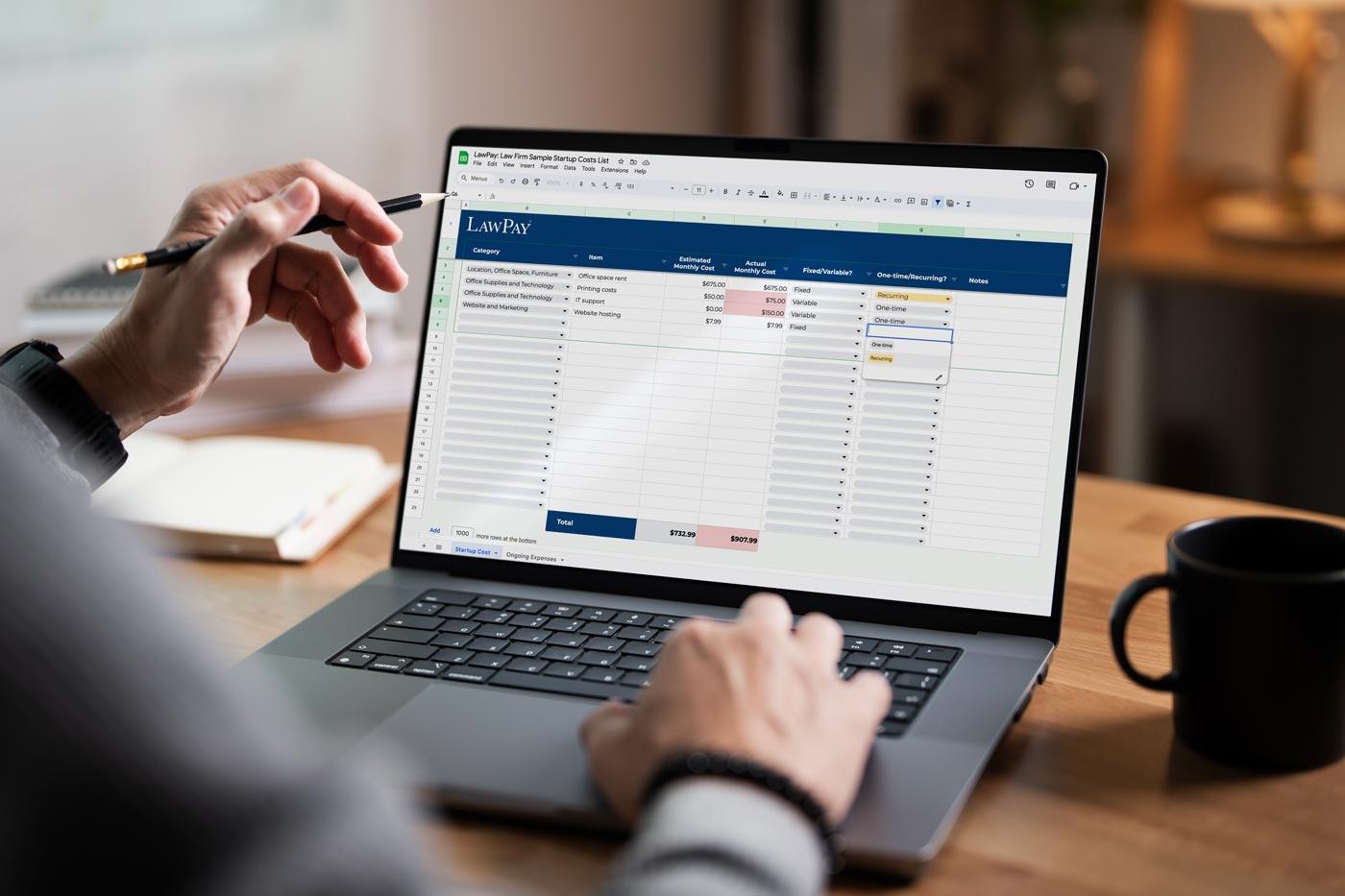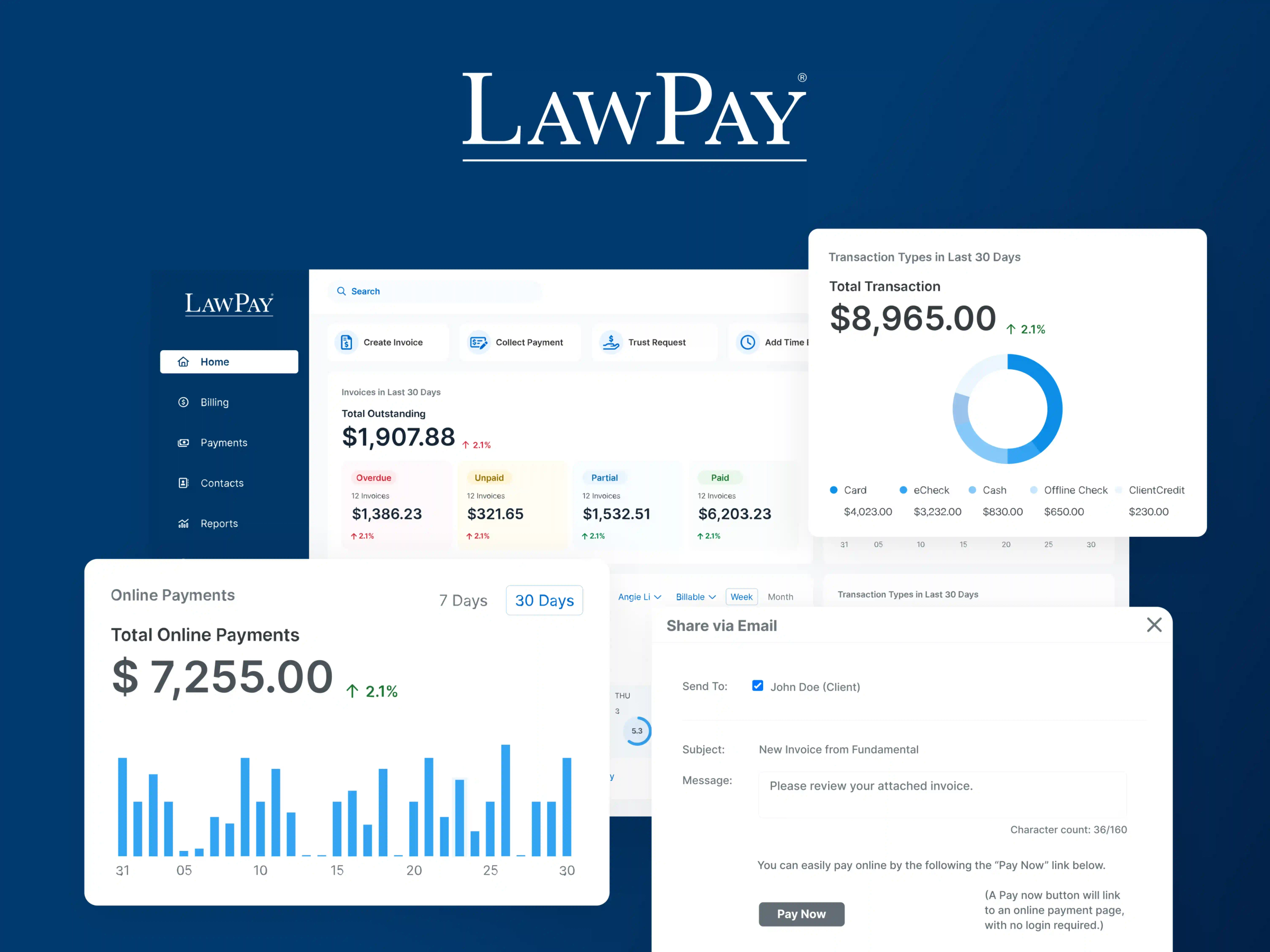While your legal expertise provides a leg up when starting a law firm, you’ll quickly find that long-term financial success requires more than winning cases and billing hours. You may anticipate costs like office space and technology, but unexpected or poorly managed expenses can consume your time and threaten your business’s financial health. Effective expense planning and management can help you both manage your time and create a clear path for sustainable growth.
In this article, we’ll provide an overview of the most common law firm costs (including startup and ongoing costs), key tips for managing these costs, and law firm funding options to help you most effectively finance the start of your firm.
Expense Category | Average Cost | Type |
|---|---|---|
Location, Office Space, and Furniture | $8,000 to $23,000 per year (standard 1,000-square-foot office) | Fixed or variable |
Office Supplies and Technology | $1,000 to $3,000 | Fixed |
Business Licensing and Insurance | $2,000 to $10,000 per lawyer per year | Fixed |
Taxes | Depends on income | Variable |
Website and Marketing | Depends on marketing needs | Variable or fixed |
Professional Expenses and Training | $1,000 to $3,000 | Fixed |
Staff, Payroll, and Benefits | 60% to 70% of total operating costs | Fixed |
Professional Services | Varies by profession and needs, but often $150-$350+ per hour | Fixed or variable |
Software and Other Tools | $5,000 to $20,000 | Fixed or variable |
Additional sources for prices: Office Furniture Warehouse, Business Plans
Location, Office Space, and Furniture
Expense type: fixed or variable
One of the most common law firm expenses is the physical space associated with the firm. Even if you work with clients virtually, you need a professional home. And if you meet clients in person, you’ll need to outfit your space with everything to make them comfortable.
These costs can vary. First, location matters; you'll pay a premium for office space in a city with a high cost of living, like San Francisco or New York, while a rural area will bring lower operational costs. Additionally, whether you rent or own a space will impact what you pay, and each has its own pros and cons.
Renting office space is more affordable than purchasing, but you may lack privacy and autonomy or struggle with increasing rent prices.
Owning an office space is the most expensive option, but it allows you to update the space as needed and avoid sharing space with others.
Working from home doesn't incur many additional costs beyond your personal rent or mortgage, but you may have less space to hire a team or hold client meetings.
On average, you can expect to pay about $8 to $23 per square foot, although high cost of living (HCOL) areas may be higher. For a standard 1,000-square-foot office, this adds up to $8,000 to $23,000 per year.
Furniture is a one-time cost, but it can add up, too. Furthermore,the utilities that will impact cost, such as internet, phone service, and even HVAC, water, and garbage service.
Office Setup | Cost | Pro | Con |
|---|---|---|---|
Rent/Share | Medium | Affordable option for office space | Lack of privacy and customization |
Own | High | Easy customization | High upfront and ongoing costs |
Work From Home | Low | Low cost | Lack of space for staff and client meetings |
Office Supplies and Technology
Expense type: fixed or one-time
To keep your firm running smoothly, you’ll need essential office items. These range from basic—like paper, pens, and ink—to more complex, like point-of-sale systems and computers.
Costs for these items vary, with technology like laptops running from $500-$2,000 and point of sale (POS) systems costing several hundred dollars. On the cheaper side, you can source a printer for about $100, and the cost of basic supplies like paper and pens is comparatively negligible. Overall, you may pay upwards of $3,000.
Business Licensing and Insurance
Expense type: fixed, possibly one-time
Business licensing and insurance coverage are critical law firm startup costs. As an attorney, you’re likely well aware of their importance in compliance with regulations and protecting yourself.
These costs can vary, as each state has specific licensing and insurance requirements. Licensing fees can range from $100 to $1,000 per year, and malpractice insurance costs depend on the practice area and location but can run in the thousands. You may also consider liability insurance, worker's compensation coverage (if you employ others), and any coverage required for your specific legal niche.
You must also renew many of your licenses annually—with insurance as an ongoing cost.
Taxes
Expense type: variable
What you'll pay in taxes depends on your business’s structure (whether you form an LLC, S-corp, or corporation), your location, and your income. It's standard to pay income taxes, and depending on your business structure and whether you have employees, you will also pay payroll taxes or self-employment taxes.
It's also worth thinking about attorney tax deductions available to you. For example, you may be able to lower tax payments by deducting costs for:
Advertising
Travel
Education
Supplies
Website and Marketing
Expense type: fixed or variable
Setting up a website and a law firm marketing plan is a critical part of achieving success as a new firm. A website is typically the first step, which requires initial costs for domain registration and web hosting, plus possible costs for development, design, and logo creation if you prefer to outsource this work.
Once it’s created, you can make your website work for you by implementing search engine optimization (SEO), ads, and social media.
Costs for all of these services can start at around $500 per month. While this can feel like a heavy lift at first, it will pay off over time as you attract new clients.
Professional Expenses and Training
Expense type: fixed
Ongoing education is key to consistent success in running a law firm. Not only is it vital to keep attorneys informed about their field, but it may also be required by state licensing boards.
These expenses can run anywhere from $1,000 to $5,000 or more per year, depending on how many courses or trainings you take and what resources you access. However, you can also find free, on-demand courses from organizations like LawPay.
You might subscribe to continuing education webinars, join professional associations with membership fees, or subscribe to relevant publications.
Staff, Payroll, and Benefits
Expense type: fixed
As your law firm grows, so do the costs of managing it. The cost of employing staff includes salaries, bonuses, and benefits. The biggest is the salary or hourly wage, which will vary based on role type and location.
For example, hiring someone to manage filing or data entry will likely run you under $40,000 per year, while hiring a paralegal may cost upwards of $60,000 to $70,000. It’s fair to expect that staff and payroll will be about 60%-70% of your total costs.
Remember, too, that hiring staff can increase other expenses. For example, hiring five employees requires five workspaces with furniture, increased payroll taxes, and possibly higher insurance premiums.
Professional Services
Expense type: fixed or variable
Rather than manage your firm's details yourself, consider outsourcing to a professional services company. Organizations like these can handle activities like accounting, IT, or human resources, letting you focus on legal work.
When budgeting for your firm, it’s helpful to balance the cost of professional services with the cost of managing those activities yourself or hiring someone to handle them internally. While you’ll likely pay $1,000 to $3,000 a year for accounting support, you’ll probably incur a higher time and opportunity cost trying to do it yourself—and you’ll definitely spend more on a full-time in-house accountant.
On the other hand, outsourcing HR services may cost another $5,000 and may not be worth it if you only have a single part-time employee.
Software and Other Tools
Expense type: fixed or variable
Software can help keep your firm running, but you’ll want to be discerning about what tools you need to keep costs down. Costs for software can range from fairly low ($30 per month for simple invoice software) to higher ($500 per month for robust practice management software).
Start by thinking about the required work and existing inefficiencies. Then, determine whether existing software can handle several of these activities at once. When considering costs, also factor in the time saved. While not monetary cost savings on its own, time saved may let you pick up more billable work and increase your revenue.
A few types of software to consider include:
Practice management systems
Software to create and track invoices and accept payments
Accounting, billing, and payment software
Lead management tools
Communication tools (e.g., email, phone)
Take accounting, for example. You could hire your own full-time accountant, which would run you about $80,000 or more per year, or you could engage a professional services firm, which could cost anywhere from $150 to $400 per hour. But if you decide to go DIY—and use the right software to help you through it—you could spend as little as $20 per month.
You can also try a comprehensive practice management software like MyCase that offers a suite of features. MyCase comes with law firm accounting features but also offers other practice and financial management tools.
Law Firm Expenses List
With so many possible law firm expenses, it’s easy to get bogged down with the question, “How much money do I need to start my own law firm, and how can I increase profitability when I do?”
Maintaining a detailed law firm expenses list will set you on the right path and let you track and categorize your expenses as you go.

Note: You must be logged in to a Google Account download the Google Sheets template.
Law Firm Funding Options
There are plenty of funding options available when starting a new law firm, ranging from the simple (using your own money) to more complicated (seeking and acquiring investors). To decide on the best type of funding, think about your current financial state and long-term objectives. You can use our starting a law firm checklist to help.
For instance, if you’ve got hundreds of thousands in savings and have a pricing structure you’re sure will bring a profit, you can likely succeed on your own funding. On the other hand, if you hope to grow exponentially, finding an investor who can help you get there might be the best bet.
Here are a few options to consider:
Self-funding, such as from personal savings, can be risky but doesn’t require additional work upfront.
Small business loans or grants take effort to find but often provide favorable terms for new businesses.
Seeking an investor is risky since you might give up equity or control, but it can have a substantial upside by providing you with capital to expand.
Tips for Managing Law Firm Startup Costs
Understanding how much it costs to start a law firm is an important first step. To maximize your profit and foster long-term business success, here are a few tips:
Negotiate, negotiate, negotiate. Asking vendors for discounts or more attractive payment terms can help reduce initial costs.
Embrace the cloud. Rather than buying standard, licensed software packages, consider scalable cloud-based systems instead.
Monitor spend. Stay aware of where your money is going by regularly auditing your budget and adjusting for unexpected expenses.
Stay prepared. Build an emergency fund so you can safeguard yourself in case of any issues.

Efficiently Manage Law Firm Expenses From the Beginning With LawPay
A lot goes into starting a new business, but one of the first steps to success is understanding how much it costs to start a law firm and how you can manage expenses. You’ll likely incur a mix of office space, supplies, technology, taxes, insurance, and hiring and management costs. Keeping track of all of these can feel like a job in and of itself.
Using technology like LawPay saves you time and effort. LawPay can help you list your law firm’s expenses and manage them with robust legal spend management. You can join the waitlist today for early access to complete visibility into your firm’s spending.
To learn more and see LawPay in action, schedule a demo today.
Schedule a demo to see what LawPay can offer your firm.
Book Now
About the author

Justin FisherContent Writer
Justin Fisher is a content writer and SEO strategist for leading legal software companies, including MyCase, Docketwise, and CASEpeer, as well as LawPay, the #1 legal payment processor. He specializes in writing about emerging legal technology, financial wellness for law firms, and more.
